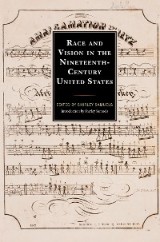Details

Race and Vision in the Nineteenth-Century United States
|
36,99 € |
|
| Verlag: | Lexington Books |
| Format: | EPUB, PDF |
| Veröffentl.: | 08.11.2019 |
| ISBN/EAN: | 9781498573122 |
| Sprache: | englisch |
| Anzahl Seiten: | 236 |
DRM-geschütztes eBook, Sie benötigen z.B. Adobe Digital Editions und eine Adobe ID zum Lesen.
Beschreibungen
<span>Race and Vision in the Nineteenth-Century United States</span>
<span> is a collection of twelve essays by cultural critics that exposes how fraught relations of identity and race appear through imaging technologies in architecture, scientific discourse, sculpture, photography, painting, music, theater, and, finally, the twenty-first century visual commentary of Kara Walker. Throughout these essays, the racial practices of the nineteenth century are juxtaposed with literary practices involving some of the most prominent writers about race and identity, such as Herman Melville and Harriet Beecher Stowe, as well as the technologies of performance including theater and music. Recent work in critical theories of vision, technology, and the production of ideas about racial discourse has emphasized the inextricability of photography with notions of race and American identity. The collected essays provide a vivid sense of how imagery about race appears in the formative period of the nineteenth-century United States.</span>
<span> is a collection of twelve essays by cultural critics that exposes how fraught relations of identity and race appear through imaging technologies in architecture, scientific discourse, sculpture, photography, painting, music, theater, and, finally, the twenty-first century visual commentary of Kara Walker. Throughout these essays, the racial practices of the nineteenth century are juxtaposed with literary practices involving some of the most prominent writers about race and identity, such as Herman Melville and Harriet Beecher Stowe, as well as the technologies of performance including theater and music. Recent work in critical theories of vision, technology, and the production of ideas about racial discourse has emphasized the inextricability of photography with notions of race and American identity. The collected essays provide a vivid sense of how imagery about race appears in the formative period of the nineteenth-century United States.</span>
<span>Race and Vision in the Nineteenth-Century United States</span>
<span> presents twelve essays by cultural critics that expose fraught relations of identity and race in architecture, scientific discourse, art, photography, music, and theater, juxtaposed with prominent writers about race and identity, such as Herman Melville and Harriet Beecher Stowe.</span>
<span> presents twelve essays by cultural critics that expose fraught relations of identity and race in architecture, scientific discourse, art, photography, music, and theater, juxtaposed with prominent writers about race and identity, such as Herman Melville and Harriet Beecher Stowe.</span>
<p><span>Part 1: Articulate Spaces</span><br><br></p>
<p><span> </span><br><br></p>
<p><span>Chapter 1: The Racial Geometry of the Nation: Thomas Jefferson’s Grids and Octagons</span><br><br></p>
<p><span>Irene Cheng</span><br><br></p>
<p><br><br></p>
<p><span>Chapter 2: Arctic Whiteness: William Bradford, Herman Melville, and the Invisible Spheres of Fright </span><br><br></p>
<p><span>Wyn Kelley</span><br><br></p>
<p><br><br></p>
<p><span>Chapter 3: Music and Military Movement: Racial Representation</span><br><br></p>
<p><span>Brigitte Fielder</span><br><br></p>
<p><br><br></p>
<p><span>Chapter 4: Black Faces Etched in White Stone: Black Feminist Visuality in Edmonia Lewis’s Sculpture</span><br><br></p>
<p><span>Kelli Morgan</span><br><br></p>
<p><br><br></p>
<p><span>Chapter 5: Enchanted Optics: Excavating the Magical Empiricism of Holmesian Stereoscopic Sight</span><br><br></p>
<p><span>Cheryl Spinner</span><br><br></p>
<p><br><br></p>
<p><span>Chapter 6: Between Word and Image: The Use of Humor, Satire, and Caricature in Early Abolitionist Political Cartoons</span><br><br></p>
<p><span>Martha Cutter</span><br><br></p>
<p><br><br></p>
<p><br><br></p>
<p><span>Part 2: Democratic Visions</span><br><br></p>
<p><br><br></p>
<p><span>Chapter 7: Seeing Irony in Barnum’s America: Anti-Slavery Humor in </span><span>Uncle</span><span> </span><span>Tom’s Cabin</span><br><br></p>
<p><span>Adena Spingarn</span><br><br></p>
<p><br><br></p>
<p><span>Chapter 8: Babo’s Skull, Aranda’s Skeleton: Visualizing the Sentimentality of Race Science in </span><span>Benito Cereno</span><br><br></p>
<p><span>Christine Yao</span><br><br></p>
<p><span> </span><br><br></p>
<p><span>Chapter 9: Melville’s Greens: Color Theory and Democracy</span><br><br></p>
<p><span>Jennifer Greiman</span><br><br></p>
<p><br><br></p>
<p><span>Chapter 10: Narrative Structure as Secular Judgment in Thomas Crawford’s </span><span>Progress of Civilization</span><br><br></p>
<p><span>Kirsten Pai Buick</span><br><br></p>
<p><br><br></p>
<p><span>Chapter 11: Beheld by the Eye of God: Photography and the Promise of Democracy in Frederick Douglass’s </span><span>The Heroic Slave</span><br><br></p>
<p><span>Kya Mangrum</span><br><br></p>
<p><br><br></p>
<p><span>Chapter 12: Cotton Babies: Mama’s Maybe: Kara Walker’s Marvels of Invention</span><br><br></p>
<p><span>Janet Neary</span></p>
<p><span> </span><br><br></p>
<p><span>Chapter 1: The Racial Geometry of the Nation: Thomas Jefferson’s Grids and Octagons</span><br><br></p>
<p><span>Irene Cheng</span><br><br></p>
<p><br><br></p>
<p><span>Chapter 2: Arctic Whiteness: William Bradford, Herman Melville, and the Invisible Spheres of Fright </span><br><br></p>
<p><span>Wyn Kelley</span><br><br></p>
<p><br><br></p>
<p><span>Chapter 3: Music and Military Movement: Racial Representation</span><br><br></p>
<p><span>Brigitte Fielder</span><br><br></p>
<p><br><br></p>
<p><span>Chapter 4: Black Faces Etched in White Stone: Black Feminist Visuality in Edmonia Lewis’s Sculpture</span><br><br></p>
<p><span>Kelli Morgan</span><br><br></p>
<p><br><br></p>
<p><span>Chapter 5: Enchanted Optics: Excavating the Magical Empiricism of Holmesian Stereoscopic Sight</span><br><br></p>
<p><span>Cheryl Spinner</span><br><br></p>
<p><br><br></p>
<p><span>Chapter 6: Between Word and Image: The Use of Humor, Satire, and Caricature in Early Abolitionist Political Cartoons</span><br><br></p>
<p><span>Martha Cutter</span><br><br></p>
<p><br><br></p>
<p><br><br></p>
<p><span>Part 2: Democratic Visions</span><br><br></p>
<p><br><br></p>
<p><span>Chapter 7: Seeing Irony in Barnum’s America: Anti-Slavery Humor in </span><span>Uncle</span><span> </span><span>Tom’s Cabin</span><br><br></p>
<p><span>Adena Spingarn</span><br><br></p>
<p><br><br></p>
<p><span>Chapter 8: Babo’s Skull, Aranda’s Skeleton: Visualizing the Sentimentality of Race Science in </span><span>Benito Cereno</span><br><br></p>
<p><span>Christine Yao</span><br><br></p>
<p><span> </span><br><br></p>
<p><span>Chapter 9: Melville’s Greens: Color Theory and Democracy</span><br><br></p>
<p><span>Jennifer Greiman</span><br><br></p>
<p><br><br></p>
<p><span>Chapter 10: Narrative Structure as Secular Judgment in Thomas Crawford’s </span><span>Progress of Civilization</span><br><br></p>
<p><span>Kirsten Pai Buick</span><br><br></p>
<p><br><br></p>
<p><span>Chapter 11: Beheld by the Eye of God: Photography and the Promise of Democracy in Frederick Douglass’s </span><span>The Heroic Slave</span><br><br></p>
<p><span>Kya Mangrum</span><br><br></p>
<p><br><br></p>
<p><span>Chapter 12: Cotton Babies: Mama’s Maybe: Kara Walker’s Marvels of Invention</span><br><br></p>
<p><span>Janet Neary</span></p>
<span>Shirley Samuels</span>
<span> is professor of English and American studies at Cornell University.</span>
<span> is professor of English and American studies at Cornell University.</span>

















